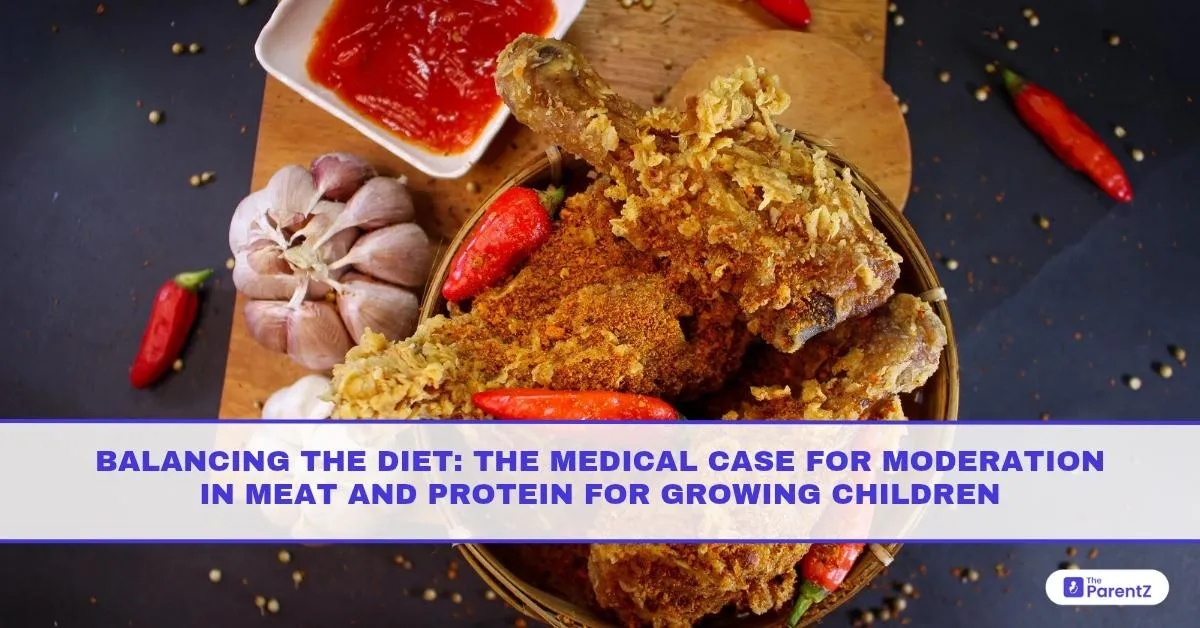Not Just What They Eat But How Much
In the name of “building strength,” many growing children today are served generous portions of meat and protein-rich foods, often far exceeding what their bodies actually need. From meat-heavy school tiffins to post-sport protein shakes, the emphasis on protein has grown rapidly in Indian homes.
But does more always mean better?
From a dental and medical standpoint, the answer is no. While protein is vital for development, too much of it, especially from meat, can create complications that show up in digestion, oral health, and overall balance.
Understanding a Child’s Real Needs
Children require protein for growth, tissue repair, immune support, and muscle development. However, protein needs vary by age, activity, and individual metabolism. Here’s a general estimate (per Indian Council of Medical Research):
- 1–3 years: ~13 grams/day
- 4–6 years: ~20 grams/day
- 7–9 years: ~29 grams/day
- 10–12 years: ~39 grams/day
These needs are easily met with regular meals that include dal, roti, milk, curd, eggs, and a mix of plant and animal foods. Unfortunately, many children today are being given twice or even thrice these amounts, often unknowingly.
Where the Excess Comes From
- Meat twice a day instead of once or twice a week
- Multiple eggs daily with no balancing fruits or vegetables
- Supplements marketed as “health drinks” or “height gainers”
- Gym-style protein powders in teens without medical advice
The problem isn’t protein itself but its overemphasis at the cost of balance.
Health Effects of Too Much Protein and Meat
1. Kidney Load
Animal protein, especially red meat, increases the production of nitrogenous waste products like urea. The kidneys must filter this out. In children, immature kidney function may struggle with excess, increasing the risk of dehydration, electrolyte imbalance, and long-term stress.
2. Constipation and Digestive Discomfort
Meat lacks dietary fiber. When protein-heavy meals replace vegetables and whole grains, children often experience:
- Sluggish bowel movements
- Reduced appetite
- A tendency to avoid meals due to bloating
3. Weight Imbalance
While protein supports muscle growth, unused protein converts to fat. This, combined with low fiber and inactivity, can tip the balance toward early weight gain and insulin resistance.
4. Nutrient Displacement
When children fill up on protein, they often eat fewer fruits, vegetables, and whole grains—missing out on essential vitamins like C and folate, and minerals like calcium and magnesium.
From a Dentist’s View: The Mouth Reflects the Meal
While sugar is the usual suspect in dental issues, high-meat, low-plant diets also impact oral health. Here’s how:
- Meat fibers can lodge between teeth, especially molars, causing decay if not cleaned properly.
- Low water intake, common in high-protein diets, reduces saliva flow, leading to dry mouth and higher cavity risk.
- Bad breath is more frequent in children on meat-rich or high-protein diets, due to protein breakdown by oral bacteria.
- Chewing strain: Tough meat can cause discomfort in children with erupting or misaligned teeth.
Oral discomfort often leads to poor chewing and even selective eating habits, worsening dietary imbalances.
Do All Children Need the Same Protein?
Not at all.
Who might need slightly more protein:
- Underweight children with poor appetite
- Children recovering from illness
- Active adolescents in sports (under medical guidance)
But even here, the focus should be food-first, not supplement-first.
For most children, home-cooked meals are enough. Over-supplementation or blindly copying adult-style diets is not appropriate for young bodies still in development.
How to Get the Balance Right
Instead of tracking grams obsessively, observe your child’s plate across the day:
- Include 1 portion of protein at major meals (dal, eggs, paneer, or lean meat)
- Keep vegetables and grains in proportion—they’re not side dishes
- Encourage fruit intake—at least one whole fruit daily
- Hydrate well—especially if consuming high-protein meals
- Limit red meat to once a week—goat, beef, or pork should not be daily items
- Use eggs or dairy as safer everyday options
Protein Doesn’t Always Mean Meat
India offers a variety of non-meat protein options that are gentle on the gut and easy to prepare:
- Moong dal, masoor dal, chana dal
- Besan (gram flour) in cheelas or parathas
- Tofu or paneer
- Boiled or sprouted legumes
- Curd, lassi, or buttermilk
- Nuts and seeds in moderation
These provide fiber, micronutrients, and digestibility along with protein—perfect for children.
Signs Your Child May Be Getting Too Much Protein or Meat
If your child is regularly experiencing the following, it may be worth evaluating their protein intake:
- Complaints of stomach pain or heaviness
- Reduced appetite for simple foods
- Dry mouth or increased thirst
- Frequent constipation
- Bad breath despite brushing
- Lack of interest in fruits or other food groups
Consult a pediatrician or pediatric dentist if these symptoms persist.
Encouraging Lifelong Food Wisdom
Rather than labelling meat or protein as “bad,” teach your child the value of moderation. Children mimic adults if they see balanced meals and variety on your plate, they will adopt similar preferences.
Mealtime should be a chance to build body trust, not just muscle mass.
Closing Thoughts: A Message from the Clinic
“Every week, I see children with oral issues that trace back to food habits, not just sugar, but protein-heavy diets lacking balance. Parents often think they’re helping growth by increasing meat or eggs, but we forget children’s systems are still adjusting. It’s not about restriction but rhythm. Let the child’s plate be guided by what nourishes, not what’s trending.”
Growth happens best in an environment of balance: nutritional, emotional, and developmental. Let your child’s meals support their energy, health, and happiness, without tipping too far in any one direction.
Because in childhood, food isn’t just fuel, it’s the foundation.









Be the first one to comment on this story.